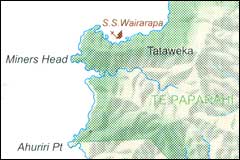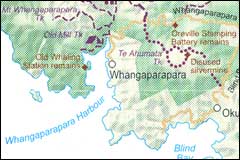|
|
|||
|
||||
|
Updated: September 12, 2001 |
|
|
||||||||||||||||||||||||||||||||||||||||||||||||||||||||||||||||||||||||||||||||
 Copper was mined at Miners' Head in the mid-1800s |
|
 Rocks were crushed to recover gold and silver at Whangaparapara in the 1890s |
Great Barrier Island had a great wealth of ore including silver, gold, zinc and lead.
In 1841 copper was discovered and mining commenced in 1842 at Te Mata (Miners Head). The easily mined ore was gone in a few years and the mine closed in 1867. The mine is still visible by boat around the coastal headland on the northwest coast (see map).
In the 1890s' gold and silver was discovered on the southern side of Te Ahumata at Okupu/Whangaparapara. Over 1,300 kg of ore was mined. The stamping battery that crushed the rock remains today from the 1899 Oroville Company at Whangaparapara.
Today Te Ahumata still has mining applications on it.